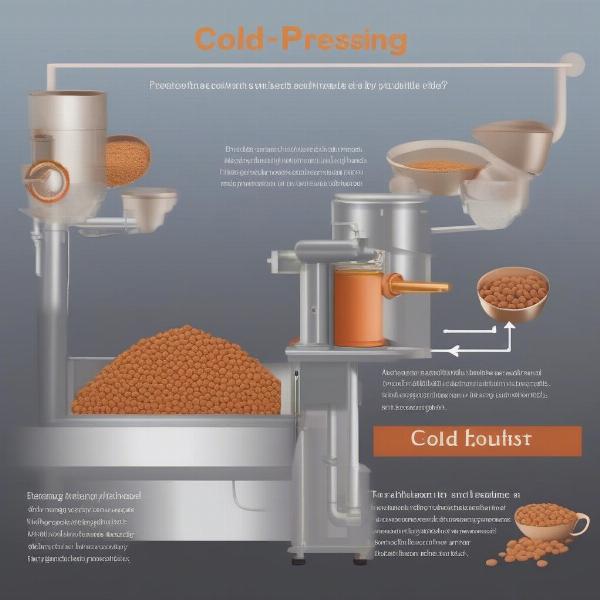Cold press dog food is gaining popularity amongst pet owners seeking a healthier and more natural diet for their furry friends. This comprehensive guide dives into the world of cold pressed dog food, exploring its benefits, potential drawbacks, and how it differs from traditional kibble and raw feeding. We’ll also help you determine if this increasingly popular dog food is the right choice for your canine companion.
What is Cold Pressed Dog Food?
Cold pressed dog food is made using a unique process that avoids the high temperatures used in traditional kibble extrusion. Instead, the ingredients are gently pressed together at lower temperatures, preserving more of their natural nutrients and enzymes. This process results in a denser, more nutrient-rich kibble that is also easier to digest.
 Cold Pressed Dog Food Production Process
Cold Pressed Dog Food Production Process
Benefits of Cold Pressed Dog Food
Many proponents of cold pressed dog food highlight its numerous advantages, including:
- Higher Nutrient Retention: The lower processing temperatures help retain vital vitamins, minerals, and antioxidants, leading to a more nutritious meal.
- Improved Digestibility: The dense kibble breaks down more easily in the stomach, reducing the risk of bloating and other digestive issues.
- Enhanced Palatability: Many dogs find the taste and texture of cold pressed food more appealing than traditional kibble.
- Smaller Feeding Portions: Due to its higher nutrient density, you often need to feed less cold pressed food than kibble, making it potentially more cost-effective in the long run.
- Natural Ingredients: Many cold pressed dog food brands prioritize natural, wholesome ingredients, avoiding artificial additives and fillers.
Cold Pressed vs. Kibble and Raw Feeding
How does cold pressed dog food stack up against other popular feeding options like kibble and raw food? Let’s explore the key differences.
Cold Pressed vs. Kibble
Traditional kibble is made through extrusion, a high-heat process that can degrade some nutrients. Cold pressing retains more nutrients due to its gentler processing methods. Kibble also tends to expand in the stomach, potentially causing bloating, while cold pressed food breaks down more easily.
Cold Pressed vs. Raw
Raw feeding involves giving your dog uncooked meat, bones, and vegetables. While raw diets can be beneficial, they require careful preparation and balancing to ensure nutritional completeness. Cold pressed offers a convenient alternative with a similar focus on nutrient retention but without the risks associated with handling raw meat.
Choosing the Right Cold Pressed Dog Food
With various cold pressed dog food brands available, selecting the best one for your dog can be overwhelming. Consider these factors:
- Life Stage: Choose a formula tailored to your dog’s age, breed size, and activity level (puppy, adult, senior).
- Ingredients: Look for high-quality, natural ingredients and avoid artificial additives, fillers, and by-products.
- Nutritional Needs: If your dog has any specific dietary requirements or allergies, ensure the chosen food addresses those needs.
- Budget: Cold pressed dog food is typically more expensive than kibble, so factor this into your decision.
Is Cold Pressed Dog Food Right For Your Dog?
Cold pressed dog food offers a compelling alternative to traditional kibble and raw feeding, prioritizing nutrient retention and digestibility. While it might be slightly pricier, the potential benefits, including improved digestion, coat health, and overall well-being, make it a worthwhile consideration for many dog owners. Consulting with your veterinarian can help you determine if switching to cold pressed dog food is the right choice for your individual dog’s needs.
FAQ
- Is cold pressed dog food suitable for puppies? Yes, some brands offer puppy-specific formulas.
- Can I mix cold pressed food with kibble? While possible, it’s generally recommended to transition gradually to one type of food.
- Where can I buy cold pressed dog food? You can find it in specialty pet stores, online retailers, and sometimes at your veterinarian’s office.
- Is cold pressed dog food more expensive than kibble? Generally, yes, due to the specialized production process.
- Does cold pressed food need to be refrigerated? No, but store it in a cool, dry place.
- How much cold pressed food should I feed my dog? Follow the feeding guidelines on the packaging, adjusting based on your dog’s individual needs.
- Is cold pressed food suitable for dogs with allergies? Yes, many brands offer hypoallergenic formulas with limited ingredients.
Related Articles
ILM Dog is your trusted partner in canine care. We provide expert guidance on everything from breed selection and nutrition to training and healthcare. We offer a comprehensive range of resources and products to help you provide the best possible care for your dog. From dog mom shirts to finding the right dog christmas box, we have you covered. Contact us today at [email protected] or +44 20-3965-8624 for personalized advice. ILM Dog is dedicated to supporting your journey as a responsible and loving dog owner.